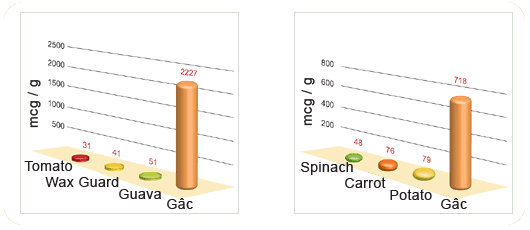

Gâc is a large, red and palatable fruit indigenous to Southern Asia. This fruit is familiar to indigenous people and is easy to grow, yet the fruit is seasonal and only available for a few months each year, harvesting of the fruits begins in September and last until December. In Vietnam, the Gâc vine is often seen growing on lattices at the entrances of rural homes.
Gâc is priced in the Vietnamese culture and has multiple uses. Gâc is used in a well-accepted dish in Vietnam called “Xoi Gac” or “Red Rice”. This dish is prepared by mixing the Gâc seed and pulp with cooked rice to impart a red color and distinct flavor. Traditionally “Xoi Gac” is served at weddings, the lunar New Year and for other important celebrations. During these occasions it's essential to mask the white color of rice, since white is considered the color of funeral. In addition to their use in “Xoi Gac”, the seed membranes are also used to make a tonic (Gâc oil) for lactating or pregnant women and children.
Lipocarotenes™
Guichard and Bui first identified carotenoids in Gâc fruit when they traveled to Vietnam in 1941 and were amazed by this “fruit from heaven” crowned by the locals. Gâc fruit is considered a “super fruit” because of its high concentrations of beta-carotene and Lycopene which is much higher than conventional fruits and vegetables. Gâc also has high levels of fatty acids which creates a lipocarotene to deliver higher bioavailable Carotenoids. Compared to beta-carotene found in dark-green vegetables, beta carotene from Gâc fruit appears to be more easily absorbed.
A Lipocarotene is a matrix of beta-carotene and fatty acids that enables efficient absorption and transport of beta-carotene and other fat soluble vitamins. Significant concentrations of long chain fatty acids, vitamin E and essential fatty acids are found in the seed membrane and pulp of the Gâc fruit.
In Vietnam, the Gâc fruit (Momordica Cochinchinensis) is a promising candidate for food-based interventions since it is rich in beta-carotene and lycopene. The seed membrane and pulp of the Gâc fruit contain significant concentrations of long-chain fatty acids, a key property for the efficient absorption and transport of beta-carotene and other fat-soluble vitamins. Locally, this fruit is mixed with rice in a preparation called “Xoi Gac”. The carotenoids in Gâc fruit (Momordica Cochinchinensis spreng) were analysed by high-performance liquid chromatography (HPLC), and the concentrations of beta-carotene, lycopene, zeaxanthin and beta-cryptoxanthin were measured. Lycopene was found to be predominantly present in the Gâc seed membrane at a concentration of up to 380 microg/g of seed membrane. The concentration of lycopene in the Gâc seed membrane was about ten-fold higher than that in known lycopene-rich fruit and vegetables, indicating that Gâc fruit could be a new and potentially valuable source of lycopene.
g3™ includes Gâc, which is known as the “fruit from heaven” by the indigenous people of southern Asia. The fruit has long been prized in the region for its ability to promote longevity and vitality. Gram for gram, Gâc provides 70 times more lycopene than a tomato and 10 times more beta-carotene than a carrot.
Super comparison

The discovery of Guichard and Bui rocked the scientific world. According to a 2004 USDA paper, Gâc aril has about 40-70 times the Lycopene of tomatoes and 10 times the beta carotene of carrots.

Apart from high content of Lycopene and Beta-Carotene, Gâc is also rich source of vitamin E and essential fatty acids.
185 preschoolers in Vietnam were involved in a 30 days controlled supplementation trial. Children with low hemoglobin concentrations were assigned to 1 of 3 groups: a fruit group, who received “Xoi Gac” that contained beta-carotene, a powder group, who received rice mixed with synthetic beta-carotene and a control group, who received rice without fortification. The mean increase in plasma beta-carotene concentrations in the fruit and powder groups was significantly greater than in the control group.
Chronic Vitamin A deficiency is a persistent nutritional problem among children in rural areas of Vietnam. Vitamin A capsules distribution programs may not represent a long-term solution, and food based interventions are viewed as part of an effective strategy for reducing vitamin A deficiency. In this strategy, provitamin A Carotenoids, particularly Beta- carotene, which provide vitamin A after enzymatic cleavage, play a key role. In Vietnam the Gâc fruit is a promising candidate for food-based interventions. It's a large, bright red fruit rich in beta-carotene and Lycopene. The seed membrane and pulp of the Gâc fruit contain significant concentration of long-chain fatty acids, a key property for the efficient absorption and transport of beta-carotene and other fat-soluble vitamins, this property is especially critical in the Vietnamese population, in whom fat intake is often low.

Beta-Carotene
Beta-Carotene is an effective anti-oxidant. It's extremely beneficial to our health due to the high content of soluble fatty-acids. Beta-Carotene is also known as provitamin A, and it's one of the most important precursors of vitamin A in the human diet.
Lycopene
Lycopene is an open-chain unsaturated carotenoid that imparts red colour to vegetables and fruits like tomatoes, rosehip, watermelon, pink grapefruit etc. Lycopene is a proven antioxidant. Antioxidants neutralize free radicals, which may damage the body's cells.
Zeaxanthin
Zeaxanthin is a close cousin to lutein. It helps to protect the retina by filtering out blue light, which is not stopped by the cornea and lens, and which can damage the retina over time.
•Gâc •Chinese Lycium •Siberian Pineapple •Cili Fruit



















